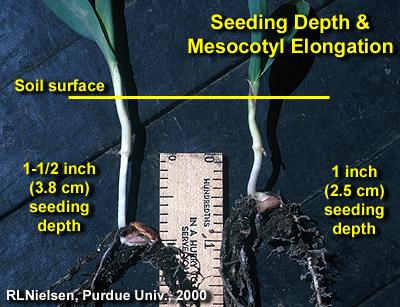
The corn plant mesocotyl, the structure between the corn seed and the crown, is responsible for pushing the coleoptile, to the soil surface. The mesocotyl also serves as a temporary pipeline between the seed and the crown, until nodal roots begin development. Experiments have demonstrated that the mesocotyl may successfully push the coleoptile to the soil surface from a depth of six inches or more, although three inches is the maximum practical emergence depth for most soils.
Normal mesocotyl elongation can be affected by weather conditions, herbicides, fertilizers, diseases and insects. Growth regulator herbicides are known to cause "corkscrew" growth of the mesocotyl or may cause the mesocotyl to "hyper-elongate," causing the corn plant's crown to be positioned too shallow in the soil, or even above the soil surface. Other herbicides may burn the mesocotyl. Wide fluctuations in day-night temperatures can cause distorted mesocotyl and/or shoot growth. Diseases, like Pythium, often target the mesocotyl, as do insects like white grubs. Free ammonia or excessive salt concentration in the soil may burn the mesocotyl, causing it to develop a brown, dry appearance. If the mesocotyl is damaged or severed before nodal roots begin to function, the seedling usually dies.
The corn plant coleoptile contains the embryonic structures that will develop into the nodal root system and all above-ground plant parts. While the mesocotyl is rapidly elongating to lift the coleoptile to the soil surface, the coleoptile is also elongating at a much slower rate. When the tip of the coleoptile breaks the soil surface and is exposed to light in red wavelengths, mesocotyl elongation stops. This causes the crown (at the base of the coleoptile) to be positioned consistently at ½ to ¾ inches in depth. So, no matter how deep the corn was originally planted, the rooting node should always be within ½ to ¾ inch of the soil surface. At the same time, expanding leaf tissue splits the coleoptile sheath and leaf emergence takes place.
Crusted, compacted, or cloddy soils may have different effects on corn emergence, mostly affecting the coleoptile. If the developing coleoptile hits an obstruction, the mesocotyl continues to push and the coleoptile may split, causing the corn plant to leaf out underground. Under these conditions, the mesocotyl may also swell as it continues to push. In cloddy soils, the coleoptile may sense light between the soil clods, causing the coleoptile sheath to split and leaves (plumule) emerge, only to have these newly emerged leaves run into more soil clods.
One of the strangest growth effects occurs when corn is emerging in loose, fluffy soil, or where there is a deep, loose layer of crop residue. The mesocotyl continues to push the coleoptile until the coleoptile senses light. This positions the crown within ¾ inch of the surface. However, if the loose soil or residue later settles around the plants, this may leave the rooting node too shallow and rootless corn symptoms develop. The same is true where erosion moves soil away from the rooting node. Use of 2,4-D as part of a burndown or preplant herbicide application can sometimes cause hyper-elongation of the mesocotyl or can cause distorted growth. Planting the corn too shallow may also cause the crown to be too close to the soil surface.
Useful Tip:
When corn is seeded very shallow (less than about 1/2 inch), the crown of the coleoptile will naturally be closer to the soil surface if not right at the surface. Subsequent development of the nodal root system can be restricted by exposure to high temperatures and dry surface soils.
Contact your FS Crop Specailist for your agronomic information.
Image 1. Variation in mesocotyl elongation based on planting depth (Source: RLNielsen, Purdue University)